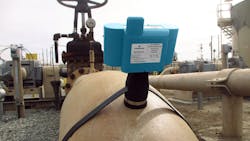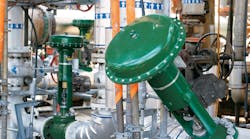In the winter, when demand for gas is high, the transmission network will see increased volumes through the system. The fast extraction required to meet demand brings an increase in undesirable solids from the underground storage caverns or reservoirs. These solids can damage pipework and equipment attached to the piping, causing erosion and potentially resulting in loss of containment or more severe incidents.
Erosion is the often unseen danger that can cause problems unexpectedly. Monitoring the integrity of the equipment during the retrieval is a sensible solution to ensuring the safety of personnel and the environment while maintaining the high utilization demanded by the gas network.
Challenge
The challenge to the equipment and safety comes when operators need to run their process at maximum utilization, pushing the limits of material and equipment. Gas retrieval forces high-speed solids to carry over from the reservoir to topside facilities. Measuring the erosive rate of solids particles and fluid are key indicators of risk that help operators maximize retrieval operations.
Managing the risk of containment is not an afterthought, but operators keep in mind that they can be fined for not delivering the required quantities of gas to the network. There is a constant tug of war between delivering while also avoiding unplanned downtime.
Solution
At times it might feel like a delicate balancing act for operators, but there are tools available that minimize the risk of unplanned downtime and still allow for maximum utilization levels. Monitoring risk and solid particles in the flow can be done with a Sand Acoustic Monitor (SAM), which gives continuous indication of solids content in the fluid and will alert operators when a threshold is reached. The SAM works as a sensor that can be mounted on the pipeline and is able to differentiate distinct signature noises of sand particles hitting the inner wall.
Similarly, inline probes supported by Rosemount 4390 Series Wireless Transmitter provide real-time fluid data directly to the operator's desk, giving insight into the equipment's corrosion or erosion risk.
Another option is to deploy a range of non-intrusive sensors suitable for any material and temperature that can measure wall thickness and report the data wirelessly. These sensors deliver frequent wall thickness readings, quantifying the actual amount of metal loss at the pipe wall without needing to stop the process.
Planning for the future
Using real-time data to keep track of pipe thickness and particles in the stream over time allows an operator to develop a comprehensive maintenance plan to avoid unwanted erosion events. Operators can also pull up historical data to indicate ongoing or repeat trouble spots along the process.
In addition, the detailed data provides an understanding of optimal flow rates and what that looks like during periods of peak demand. This gives an operator the means to best prepare for high demand periods and prevents unplanned downtime, costly fines and potential incidents.
Industry best practice
Online integrity monitoring for corrosion and erosion is fast becoming an industry standard practice with the availability of data-to-desk monitoring systems that provide a previously unavailable quality of data and frequency of online measurements. With real-time measurement data available at all times, it becomes possible to track variations in solids rates while the facility operates.
Continuous integrity monitoring in a digitally enabled facility will make meeting peak demands easier with less risk to the equipment and piping. It becomes easier to anticipate problems and plan ahead for those peak times.
William Fazackerley is a Global Product Manager at Emerson, based out of the United Kingdom. He is responsible for managing Emerson’s portfolio of wireless corrosion and erosion monitoring systems and software.


